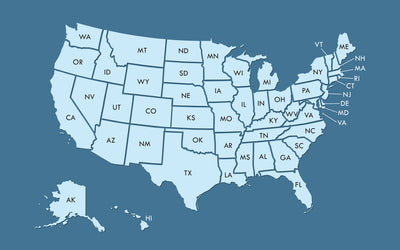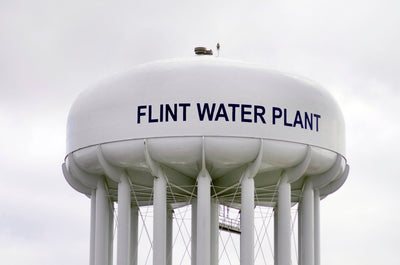Water Quality InformationWritten By Actual Experts
RSSIncome, Race, and The Availability of Safe Drinking Water in Two Michigan Cities

Does My State Regulate PFAS Chemicals in Drinking Water?

States are responding to the nationwide PFAS crisis by implementing testing or removal requirements in municipal tap water. Per and Polyfluoroalkyl Substances (PFAS) have been detected in an increasingly alarming number of municipalities across the United States. Recent studies indicate that 200 million Americans drink tap water contaminated with PFAS chemicals. On April 10, 2024, the US EPA has announced drinking water standards to limit exposure to 5 types of PFAS chemicals.
Michigan to Pay Over $600 Million to Families in Flint

Updated November 17, 2021 to include recent news
Analies Dyjak, M.A. | Policy Nerd
A judge has approved a $626 million settlement for damages from the 2014 Flint Water Crisis. The State of Michigan is required to appropriate $600 million dollars of the total into a qualified settlement fund, which will be made available to children, residents, property owners, and businesses that were impacted by water distributed by the city. Almost 80% of the $600 million is being awarded to those who were children during the time of exposure.
Background Flint Water Crisis:
On April 25, 2014, the city of Flint switched its water supply from the Detroit Water and Sewerage Department (sourced from the Detroit River and Lake Huron), to the Flint River. Officials initially switched the water supply in an effort to cut costs. Flint city officials failed to add a proper corrosion control inhibitor to the new water source during treatment. This caused lead to leach from distribution pipes, and enter the municipal system at extremely elevated levels. According to the Centers for Disease Control, 99,000 people in Flint, Michigan were exposed to elevated levels of lead. Lead is a neurotoxin, and according to the American Academy of Pediatrics, there is NO safe level for children. Despite the current 15 part per billion Federal Action Level for lead, our team at Hydroviv follows the logic that children should not ingest any level of lead.
Financial Breakdown of $600 Million Flint Settlement:
-
79.5% - Minor Children Settlements Categories: 64.5% for ages 6, 10% for ages 7-11, and 5% for ages 12-17
-
18% - Adults and Property Damage Settlement Categories: 15% for adults and 3% for property damage
-
0.5% - Business Economic Loss Settlement Category
-
2% - Programmatic Relief Settlement Category
Important Details:
If the State fails to meet these conditions within 60 days, the Plaintiff’s are able to completely rescind the entire settlement. Also, in accordance with the settlement, individuals who were minors at the time of exposure are not required to show proof of injury in order to be eligible for compensation. This should help the State of Michigan get funds out to impacted parties in a timely manner. Additionally, individuals that were minors at the time of exposure may be eligible for larger amounts of compensation if they are able to show elevated blood lead levels. A similar eligibility requirement is true for those who were adults at the time of exposure.
A Few Red Flags:
The amount of compensation made available to each individual Flint resident is entirely dependent on how many people file claims. Therefore, there’s no way to estimate the amount of money each Flint resident will receive, or if it will be sufficient enough to address all expected damages. The settlement also claims that funding will be made available to provide special education services to children exposed to high lead levels Flint. No further details were provided about these special education services or how much funding will be allocated. It's unclear if portions, or all, of the individual financial compensation funds are expected to be used for at-home special education services.>
Our Take:
The recent settlement leaves us with more questions than answers regarding the tragic Flint Water Crisis. What happened between April 24, 2014 and December 31, 2016 demonstrates what can happen to under-served and underrepresented communities in the United States. In short, it shows the worst kind of government failure. We may never truly understand the full extent of these damages, and $600 Million dollars does not even begin to address the trauma and anxiety that Flint residents face every single day. We're proud to still be working with Little Miss Flint and the Little Miss Flint Clean Water Fund to continue our charitable efforts across the entire country.
Other Articles We Think You Might Enjoy:How Does Lead Enter Drinking Water?
What You Need to Know About Disinfection Byproducts in Tap Water
How Did Hydroviv Perform in a Duke University PFAS Removal Study?
New York and Michigan Adopt PFAS Standards

Analies Dyjak, M.A. | Policy Nerd
New York and Michigan have recently set enforceable standards for PFAS contamination in drinking water. Both of these states have been hit extremely hard by PFAS contamination in the last year. Both New York and Michigan set their own PFAS standards because this category of harmful contaminants are not currently regulated by the federal government.
New York PFAS Standards:
New York State has adopted standards for two PFAS variations: PFOA and PFOS. Water utilities are now required to reduce PFOA and PFOS to 10 parts per trillion (each). Materials processing, textile manufacturing, industry and machinery services in upstate New York and on the New Jersey are responsible for the high levels of PFAS in water. An incineration facility in Cohoes, New York had been burning PFAS in the form of AFFF since 2018. A study out of Bennington College determined that PFAS were being detected downwind of the facility, and that the compounds were not being entirely burned. Further research is necessary to determine if surrounding groundwater is impacted in the town Cohoes. The New York PFAS standards are depicted in the table below:
| PFAS Chemical | NY State Maximum Contaminant Level (MCL) |
| PFOA | 10 parts per trillion |
| PFOS | 10 parts per trillion |
Michigan PFAS Standards:
Michigan Department of Environment, Great Lakes, and Energy (EGLE) has recently set enforceable standards for 7 different PFAS compounds. Michigan has been hit harder by PFAS contamination than almost any other state. In January of 2020, the state of Michigan filed a lawsuit against 17 companies for damages resulting from exposure to PFAS chemicals, and for concealing toxicological information. Some of the companies involved in the lawsuit include 3M, DuPont, and Chemours. During the summer of 2019, the Governor’s office announced a state of emergency Parchment and Cooper Township, Michigan. PFAS levels in Parchment drinking water were detected as high as 1,587 parts per trillion, which is 23 times higher than EPA’s Public Health Advisory for PFAS. The Michigan EGLE mapped out areas of the state where PFAS levels in groundwater exceed 70 parts per trillion. The Michigan PFAS standards are depicted in the table below:
| PFAS Chemical | MI State Maximum Contaminant Level (MCL) |
| PFNA | 6 parts per trillion |
| PFOA | 8 parts per trillion |
| PFOS | 16 parts per trillion |
| PFHxS | 51 parts per trillion |
| GenX | 370 parts per trillion |
| PFBS | 420 parts per trillion |
| PFHxA | 400,000 parts per trillion |
What Does This Mean for Municipalities?
Municipalities will be required to comply with new state regulations, meaning that water providers will need to update existing treatment facilities. Removing PFAS at the municipal level is not cheap. In North Carolina, a water treatment facility is updating its filtration system to remove PFAS chemicals. The initial updates will cost $35.9 million, with annual maintenance fees of $2.9 million. Rate payers are responsible for paying for these updates, which can significantly increase your monthly water bill.
Federal Standards Are Much Less Strict
For a bit of perspective, the current federal Public Health Advisory levels established by EPA are much less strict. According to EPA, PFOA and PFOS are considered “unsafe” when detected at an individual or combined concentration of 70 parts per trillion or higher. PFOA and PFOS are the only two PFAS variations that currently have federal Public Health Advisory Levels. It’s important to note that Public Health Advisories are non-enforceable, and that municipal water providers are not required to follow them. If a contaminant is detected at a level higher than a Public Health Advisory in a state that does not have its own MCL, the utility or municipality is not required to take action.
Other Articles You Might Enjoy:What Are Per and Polyfluoroalkyl Substances (PFAS)?
Yale: PFAS Increase Risk of Miscarriage
How Did Hydroviv Filters Perform in a PFAS Removal Study?





